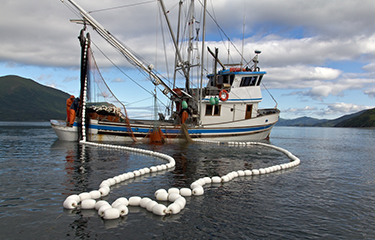Alaskan commercial fishermen are specializing more and more, leaving them more vulnerable to the immense uncertainty fishermen have to contend with, according to a new study.
Targeting a diverse array of fish types in different regions can allow fishermen to weather the ups and downs instigated by fish population changes, new regulations, deflating markets and environmental disasters. But fishermen in Alaska are increasingly specializing. Fewer fishermen are on the water than three decades ago, and those who remain are participating in fewer fisheries, according to the study, which was published in Fish and Fisheries.
“Across different fisheries and regions of Alaska, there are fewer people fishing than there used to be and their fishing portfolios have become less diverse,” Anne Beaudreau, the lead author of the study and an associate professor at the University of Alaska Fairbanks, told SeafoodSource.
Individual fishery quota systems, plus the high cost of permits and other institutional barriers, have made it more difficult for new players to enter Alaskan fisheries, according to the study.
Though fishermen could, in theory, diversify their portfolio of permits, those management restrictions and high costs often prevent them from doing so, leading to more specialization. Permits can cost hundreds of thousands of dollars depending on the fishery, Beaudreau said.
Fishermen with less diverse portfolios are generally more vulnerable to environmental, political and economic pressures that make fishing in any one fishery less profitable.
“It’s akin to diversifying your financial portfolio, where investing in a diversity of financial assets can help buffer against the ups and downs of the market,” Beaudreau said. “As you reduce the diversity of your portfolio, you have a reduced ability to buffer against unanticipated disasters.”
The study examined consolidation in Alaskan fisheries by looking at four case studies: The commercial Pacific herring fishery in Prince William Sound, the commercial Pacific halibut fishery, the commercial salmon purse seine and drift gillnet fishers, and all fisheries affected by the 1989 Exxon Valdez oil spill.
The herring fishery exemplified what happens when low fish numbers lead to the closure of a particular fishery. A persistent decline in herring in 1990s led to the eventual closure of the fishery in 1999. That closure prompted many fishermen to exit fishing altogether, though some who had diverse portfolios were able to make the switch to salmon or halibut.
The halibut fishery showed what happens when fishery management systems change. In 1995, the open access, derby-style fishery management system was replaced with an individual fishery quota system. Captains who had a history of halibut catches were assigned a share of the halibut quota.
Nearly instantly, the halibut season changed from a three-day derby session in 1994 to a 245-day season in 1995. But in the 20 years after the system was implemented, the number of quota owners fell by half. Those who remained tended to concentrate their holdings on a single geographic area.
Alaska’s various salmon fisheries have also shown increasingly specialization after a limited entry system was implemented in 1975.
Catch share and similar systems have an array of side effects, according to Rachel Donkersloot, a social scientist working on fisheries issues in Alaska, where she manages her own research and consulting firm – Coastal Cultures Research.
“Many young fishing community members and fishermen starting off view fisheries managed by catch shares as an unviable opportunity,” Donkersloot told SeafoodSource. “We currently manage our fisheries in silos and these silos are expensive to enter. The halibut IFQ fishery is a clear example of this. Young and rural fishermen can simply not afford the access rights to enter into this fishery. The debt-to-income ratio is not viable for most.”
At the same time, variability in some species has prompted fishermen to increasingly rely on salmon, according to Eric Ward, a statistician at the Northwest Fisheries Science Center, who helped develop the models and summarized the data for the consolidation study.
Fishermen experience a much higher level of income variability than the average population, Ward said. While 60 percent of the U.S. population has stable income year-to-year, only about one-third of Alaska fishermen do.
Salmon have functioned as a safety net for fishermen, Ward told SeafoodSource.
“It’s pretty amazing how salmon have provided opportunities in multiple ecosystems or regions in Alaska, during multiple kinds of perturbations,” including boom-and-bust cycles for herring and environmental disasters such as the Exxon Valdez spill, Ward said.







